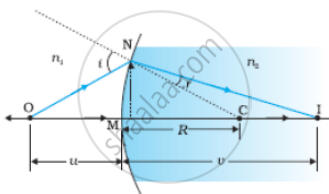Advertisements
Advertisements
प्रश्न
A point-object is placed on the principal axis of convex spherical surface of radius of curvature R, which separates the two media of refractive indices n1 and n2 (n2>n1). Draw the ray diagram and deduce the relation between the distance of the object (u), distance of the image (v) and the radius of curvature (R for refraction to take place at the convex spherical surface from rarer to denser medium.
उत्तर
(a)

Refraction at a spherical surface separating two media.
The figure shows the geometry of the formation of the image I of an object O on the principal axis of a spherical surface with center of curvature C, and radius of curvature R. The rays are incident from a medium of refractive index n1, to another of refractive index n2. As before, we take the aperture (or the lateral size) of the surface to be small compared to other distances involved, so that small angle approximation can be made. In particular, NM will be taken to be nearly equal to the length of the perpendicular from the point N on the principal axis.
We have, for small angles,
tan ∠NOM = `"MN"/"OM"`
tan ∠NCM = `"MN"/"MC"`
tan ∠NIM = `"MN"/"MI"`
Now, for ΔNOC, is the exterior angle. Therefore i = ∠NOM + ∠NCM
i = `"MN"/"OM" + "MN"/"MC"`................(1)
Similarly,
r = ∠NCM - ∠NIM
i.e., r = `"MN"/"MC" - "MN"/"MI"`..............(2)
Now, by Snell’s law
n1sin i = n2sin r
or for small angles
n1i = n2r
Substituting i and r from Eqs.(1) and (2), we get
`"n"_1/"OM" + "n"_2/"MI" = ("n"_2-"n"_1)/"MC"`............(3)
Here, OM, MI, and MC represent magnitudes of distances. Applying the Cartesian sign convention,
OM = – u, MI = + v, MC = + R
Substituting these in Eq.(3), we get
`"n"_2/"v" - "n"_1/"u" = ("n"_2-"n"_1)/"R"`..................(4)
Equation (4) gives us a relation between object and image distance in terms of the refractive index of the medium and the radius of curvature of the curved spherical surface. It holds for any curved spherical surface.
APPEARS IN
संबंधित प्रश्न
Use Huygens' principle to show the propagation of a plane wavefront from a denser medium to a rarer medium. Hence find the ratio of the speeds of wavefronts in the two media.
When light travels from an optically denser medium to a rarer medium, why does the critical angle of incidence depend on the colour of light?
When a wave is propagating from a rarer to a denser medium, which characteristic of the wave does not change and why?
